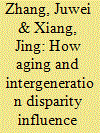|
|
|
Sort Order |
|
|
|
Items / Page
|
|
|
|
|
|
|
| Srl | Item |
| 1 |
ID:
131401


|
|
|
|
|
| Publication |
2014.
|
| Summary/Abstract |
Concurrent with market economic reforms, China is facing an increasing income gap and an aging population. The question addressed in the present paper is how much aging contributes to the rising disparity in consumption. Based on the model established by Ohtake and Saito (1998), our study shows that cohort effects contribute close to 60 percent of the rising consumption inequality, while approximately 10 percent is the result of aging. The growth of aggregate consumption inequality caused by the cohort effect has various implications. Strengthening the redistribution system, especially the tax system, may enable the economy to avoid further increases in income inequality.
|
|
|
|
|
|
|
|
|
|
|
|
|
|
|
|
| 2 |
ID:
116523


|
|
|
|
|
| Publication |
2012.
|
| Summary/Abstract |
Most existing studies of food demand focus on economic factors, such as income and price. Physical factors which determine human energy intake requirement, given economic conditions, such as gender and age structures of the population as well as occupation, are usually not incorporated. While this is appropriate in the situation of a continuous, stable development of demographic structure, it might lead to biased result if drastic and irregular demographic changes have taken place. This paper provides a case study of China of the impact of demographic dynamics on the change of physical requirement and energy intake demand. The unique population pyramid in China, resulted from the big famine in the early 1960s and then the "One Child" policy" starting from the 1980s, has led to the irregular evolution of age groups and the consequent changes in the proportion of the "big-eaters". As a result, given food price and income, the very age structure of the population at the time affects the overall weighted energy intake level of the population significantly. Using household survey data ranging from year 1991 to 2009, the index of Adult Male Equivalent Scale (AMES) is constructed to reflect the varying per capita physical requirement resulted from the demographic dynamic over the years in China. The AMES index, together with food price and income, has been applied to the per capita energy intake model. The empirical results show that the AMES index has statically strong impact on per capita energy intake, and the inclusion of the AMES index into the model has improved the model fitness. This finding sheds light on a possible way for improvement in projecting China's food demand in the future by incorporating the country's changing demographic factors.
|
|
|
|
|
|
|
|
|
|
|
|
|
|
|
|
|
|
|
|
|